Scott Meier, AABR Board Member
BARRC (Bushland and Rainforest Restoration & Consulting).
Littoral Rainforest (LRF) occurs in small pockets along the east coast of Australia from Cape York Peninsula into Victoria and is often described as being confined to within 2km of the ocean or major estuary. It is a fire sensitive community that often presents as the shortest form of ‘rainforest’, sometimes less than knee height. It grades into a taller rain-shrubland then develops taller and straighter trunks behind the protective ‘leading edge’, especially as the site levels or descends into sheltered creek-lines with additional protection from drying and salt laden winds and fire.
This closed canopy mesic vegetation community can inhabit rocky and exposed coastal cliffs, and the sheltered corners provided by headlands. But it also occurs on aeolian sands, alluvial deposits, sedimentary soils and volcanics located in other fire protected locations.
Littoral Rainforest is listed as Critically Endangered under the Federal Environmental Protection and Biodiversity Conservation Act (EPBC). The Act’s listing advice estimates 16,135ha remaining LRF in Queensland, 1,624ha in NSW and 279ha in Victoria. LRF is listed as Endangered under the NSW Biodiversity Conservation Act (2016).
In NSW, the area where I reside, Alex Floyd (1990) in his climactic classification, places Littoral Rainforest in the subtropical subformation, grouped under the Cupaniopsis anacardioides (tuckeroo) – Acmena spp. (lillypilly) alliance, and identifies 5 suballiances of LRF within: Syzygium luehmanii- Acmena helilampera; Cupaniopsis anacardioides; Lophostemon confertus; Drypetes – Sarcomelicope – Cassine – Podocarpus; and Acmena smithii – Ficus spp. – Livistona – Podocarpus.
In our contemporary landscape LRF is often highly fragmented, near residential areas and recreation areas. Many of the remnants are tiny, with an estimated 433 patches in NSW – the majority in the 1-10ha patch size (EPBC Listing advice). These patches are often impacted by recreation, coastal erosion, changed hydrology and heavy weed invasion.
Use the correct strategy for the leading edge
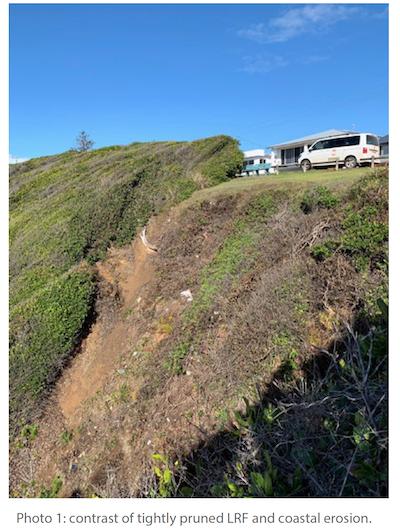 In my experience, working on the east coast of NSW, LRF is among the least understood vegetation communities when it comes to restoration. Incorrect strategy can greatly lengthen restoration timeframes and severely impact otherwise intact canopy which can take decades to repair.
In my experience, working on the east coast of NSW, LRF is among the least understood vegetation communities when it comes to restoration. Incorrect strategy can greatly lengthen restoration timeframes and severely impact otherwise intact canopy which can take decades to repair.
It is imperative to understand that the ‘leading edge’ of Littoral Rainforest canopy in many locations is almost continually pruned by drying, salt-laden breezes and winds that can be very strong. Established LRF often presents with a canopy that appears as a manicured hedge (see photo 1). The leaves are often smaller, thicker, and stiffer than equivalent species occurring beyond the leading edge and are tightly packed with only defoliated branch tips projecting beyond the otherwise uniform and carefully curved and closed canopy. This canopy is usually tangled with an array of native vines that help bind the shrubs or trees together and buffer against coastal storms. Should a canopy break appear, vines are often the first to fill the gap and protect from wind entering beneath the canopy.
Allowing wind beneath the canopy of LRF can have long term consequences for the vegetation upwind of the canopy gap. I have witnessed bush regeneration projects where leading-edge LRF weeds have been comprehensively removed and canopy height upwind has been severely affected and remains less than half the original height more than 20 years later. Photo 2 shows the effect of removing leading edge weeds and cutting dead and living trees for firewood. In this situation, young, straight, and similar age tuckeroo sp on the skyline indicate a historic germination or equivalent low-canopy release event and subsequent competition for light amongst many trees.
Most LRF trees, in my experience on the NSW coast, cannot develop this tall and straight habit in isolation. Following the removal of leading-edge vegetation and wind barriers, it is a common occurrence for the remaining taller trees to steadily die as is demonstrated in this photo. I have observed the trees of the headland portrayed in photo 2. They are thin and fall over a period of many years, and now these few remain. It is unlikely that any of the isolated trees in this photo will survive to the point where the subcanopy joins the emergent canopy. As a point of interest, the sclerophyll component of the canopy in the left of this photo probably informs us of the indigenous management of this small headland.
When considering removal of weed species from the leading edge of LRF, it is crucial to estimate the canopy ‘step’ height that will be created, the size of the gap and the speed with which other species will fill the gap. Such a scenario can be encountered when controlling lantana or bitou bush on the leading edge. In many of these scenarios I would recommend pruning of woody weed species or selective branch removal, to allow natives to develop and harden their new-growth prior to further weed pruning or complete weed control – this may take several years. Additionally, it is often best to leave the woody weed frame in place to allow native vines to utilise the structure as a trellis, also the remaining controlled weed frames and leaves offer minor wind protection.
Careful attention should be paid to larger rainforest trees when they are heavily overgrown with vines or woody climbers, be the vines or climbers native or exotic. In the first instance it is advisable to control only 10% of the smothering plant. As the new growth develops amidst the remaining canopy infestation, further vine pruning can occur. Failure to stage canopy development will most likely see a significant flush of fragile new growth. This can subsequently be wind pruned and killed to the extent that the tree will be required to reshoot from much further down the trunk and effectively reduce the canopy height of the tree by 90%. In the event of successful canopy development, the remaining vines or weedy climbers must be regularly assessed and pruned to prevent the newly forming branches from collapse by the rapid growth of remaining vines etc. This attention to detail is usually not required when restoring other types of rainforests.
Leading edge LRF restoration may be required to commence many metres in front of established shrubs and trees. This can be done with a diversity of groundcovers, trees, shrubs and vines and any suitable structure. Simple post & wire ‘message fences’ may be required to exclude pedestrian access. These fences can then have material attached to form a temporary wind barrier (photo 3). Groundcovers such as kangaroo grass, blady grass and scaevola are often an important first shelter for spontaneous (natural) or facilitated (assisted) regeneration of trees and shrubs whose germination can be triggered by gentle disturbance during selective weed removal. Fast growing Acacia sp are ideal for sheltering exposed rainforest shrubs with sparse foliage and this allows them to develop a full protective barrier of leaves.
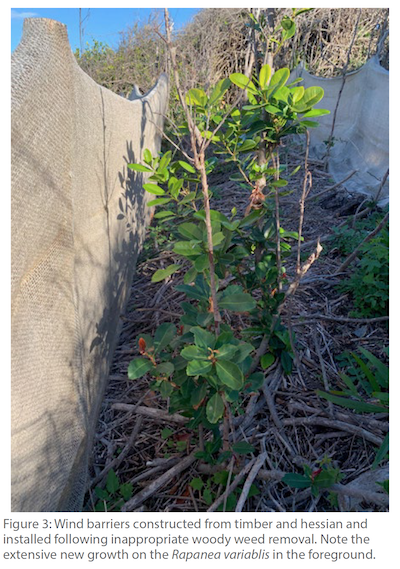 A note with respect to wind barriers in aeolian wind-blown sand environments. These temporary fences can at times become completely buried by shifting sands and may be very difficult to remove. In these situations, it is often best to construct the fence and wind barrier from natural materials that can remain on site and decompose over time. I have seen many dune restoration sites with countless meters of plastic ‘silt-fence’ buried with no intention of removal. This plastic refuse has no place buried within dune systems where significant indigenous artefacts and burials often occur.
A note with respect to wind barriers in aeolian wind-blown sand environments. These temporary fences can at times become completely buried by shifting sands and may be very difficult to remove. In these situations, it is often best to construct the fence and wind barrier from natural materials that can remain on site and decompose over time. I have seen many dune restoration sites with countless meters of plastic ‘silt-fence’ buried with no intention of removal. This plastic refuse has no place buried within dune systems where significant indigenous artefacts and burials often occur.
It usually does not make sense to remove existing woody weed barriers to wind and unwanted access simply to replace them with a constructed barrier. Living barriers usually offer much better protection and can be fashioned over time to suit changing conditions. Weeds such as lantana and bitou bush are often ever present in the surrounding environment and their removal may contribute little to propagule availability. Ultimately it is the well-developed ecological community that plays the greater role in the minimisation of the spread of these weeds, however each site must be carefully assessed in order to make this and many other decisions regarding restoration.
Assisted or facilitated regeneration of LRF is often dominated by fast growing pioneer species in the early stages of a project. Species such as Acacia longifolia, Trema tomentosa, and Androclava fraseri can transform canopy gaps in 1-2 years and can help reduce the maintenance required from large invasive grasses, vines or other smothering exotics and natives. I find that it is important to assess the impact from each of these early succession natives and exotics. Many of the weed species do not require comprehensive control and may protect later phase germinants and suckers from herbivory, foot traffic and scorching sun. A goal during restoration of LRF should be to facilitate the development of as many mature phase trees as possible and this may involve canopy lifting or pruning any of the regenerating or remnant vegetation; placing woody structures to protect seedlings; training spikey and other vines across edge gaps and into the canopy. Pioneer species such as those listed can go from dominance to senesce and die within 3-4 years from germination, so succession must be considered from the outset. Many rainforest species are particularly capable of migrating long distances and experienced regenerators should look to encourage natural regeneration wherever possible, but not to the extent that broader areas receive inadequate attention and the vine load on immature canopy or other significant threats are not addressed.
Restoration of LRF can be a very demanding undertaking, especially in smaller remnants with many edges having low resistance to weed invasion. Restoration should be undertaken by experienced practitioners with adequate resourcing over meaningful timeframes. In many LRF restoration projects, canopy release over the widest possible area is the priority. This will promote rapid canopy development of existing vegetation which will assist with control of sub-canopy weed growth rates and weed diversity.
Comprehensive control or eradication of weed species should be reserved for ecosystem transformers or for other important reasons, such as on an eco-tone between LRF and sclerophyll vegetation surrounding the endangered magenta lillipilli (Syzygium paniculatum). This species will often germinate in close proximity to parent trees following disturbance. But it is much less likely to survive as a seedling with dense ground-cover competition from the likes of the fast-growing exotic grass Ehrharta erecta or other smothering natives and exotics of differing life forms. Tradescantia sp. can often be initially contained but later fully controlled following canopy closure or when resources allow for detailed works. Many native pioneer species will readily compete with moderate density weed competition and as this native pioneer canopy develops, weeds and strangling vines can be thinned. Later phase rainforest species will readily germinate under closed or partial canopy dominated by pioneer species, and are more likely to survive without groundcover competition in contrast to pioneer species that can usually tolerate greater groundcover competition. As with all restoration projects, adaptive management is required and prescriptions can vary on a metre-by-metre basis or remain broadly uniform throughout the project area or a region.
Reference Ecosystems and assessment
Although I’m bringing the discussion regarding ‘reference ecosystem’ towards the closure of the article, this must be carefully considered – ideally prior to project commencement. Principle 1 of the SERA National Standards for the Practice of Ecological Restoration in Australia is: ‘Ecological Restoration practice is based on an appropriate local native reference ecosystem’. This topic warrants detailed further discussion beyond this article, but by way of introduction I might reflect upon one coastal site with which I’ve been involved for 20 years. The site is approximately 1 km long and 80-100m wide and contains at least 8 vegetation communities – these being: graminoid (grass), heath, swamp sclerophyll and 5 mesic communities. Three of the mesic communities are LRF, one sub-tropical and another dry rainforest. These communities blend. Additionally, vegetation community succession is in play, which continues to be influenced by historical indigenous and colonial management and by ongoing natural disturbance such as wildfire. Five of these communities are listed under the NSW Biodiversity Conservation Act (2016) which adds complexities to management as does habitat considerations, management restrictions, resourcing, restoration practicalities and permanent hydrological changes. Inability to ‘read’ these communities and their life cycles accurately will heavily impact restoration outcomes and cost, as does the inability to combine the other listed considerations.
Triage of a site is amongst the most difficult of restoration tasks. Rapid on-ground site assessment and the need to commence restoration activity in a short timeframe is commonplace. These early steps are best undertaken with all the relevant representatives from funders to managers, owners (traditional & otherwise) and practitioners. As per a medical practitioner, I find that assessing for threats is a critical early step. With respect to vegetation, I find it very important to distinguish the specific role of facilitating seedling regeneration from stabilising the site and addressing the most pressing threats. Threats can be from erosion, nutrient runoff, flooding or vines and many other directions – the most impacting threats should be controlled or contained over the largest possible area – generally prior to seeking regeneration or applying reintroduction such as planting or propagule dispersal. This is often because of the practicalities of avoiding damage to desirable seedlings and regrowth while attempting to arrest threats such as erosion or heavy weed infestation that requires efficient control techniques.
We must also consider that threats can be written into site specifications, and in my experience they regularly are. If so, these issues will probably need to be addressed prior to on-ground works commencing.
Amidst the broader restoration backdrop of goodwill and many stellar and pioneering restoration outcomes there is, in my opinion, a significant amount of restoration practice and management that is poor and unacceptable and does not do justice to the millennia of indigenous management, the pioneers of our industry or meet the urgency of global biodiversity collapse. I envisage a revitalised restoration movement, celebrating depth of practice and knowledge, with broader voices brought to the table along with a spirit willing to address our individual and collective missteps – ecodaptive management. How privileged are we to undertake such restorative action in the socio-natural sphere?
This article was produced for AABR News 158 – March 2024

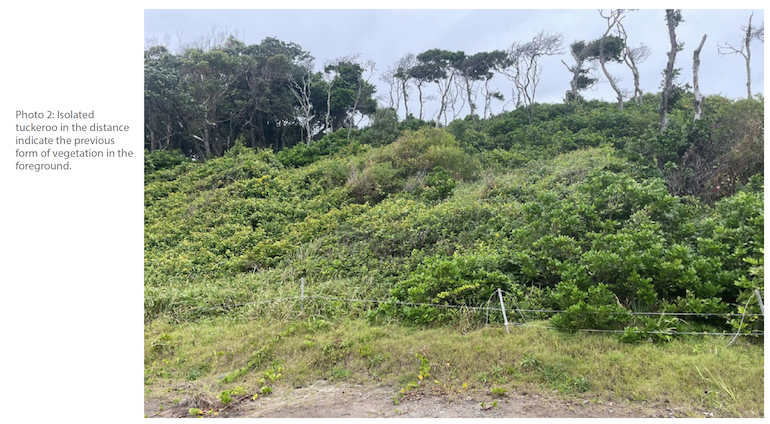
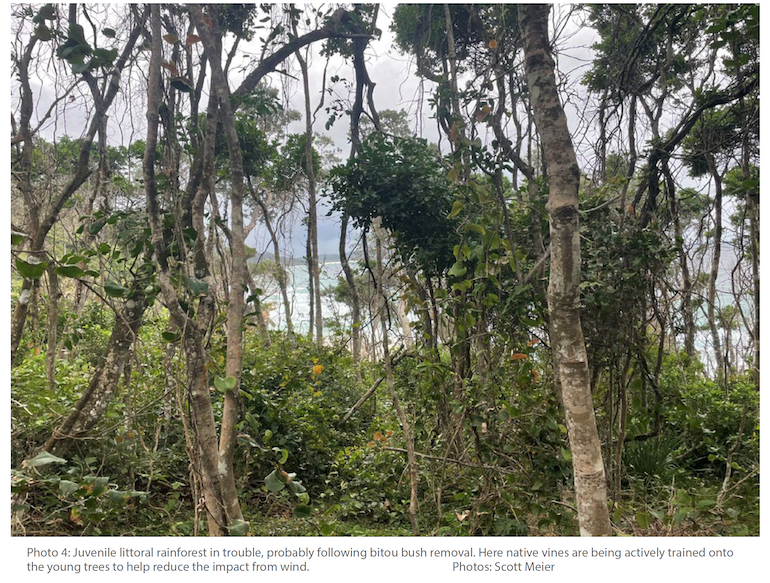

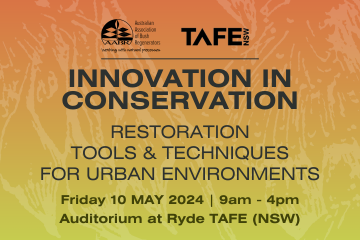
Leave A Comment